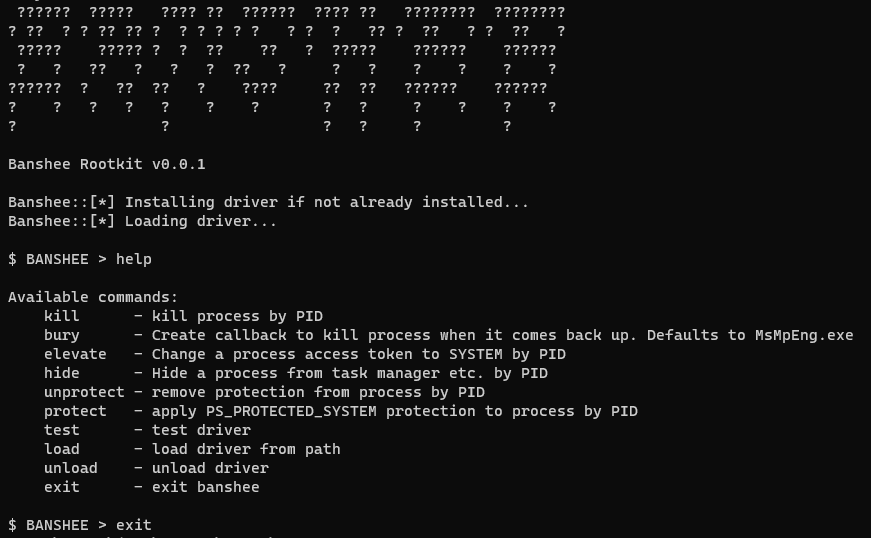Learning about Windows rootkits lately, so here is my own implementation of some techniques. For an overview, see Features below.
This is not ready to use as the code is bad and I am just learning about kernel driver development, so this is for educational purposes mainly.
http://phrack.org/issues/55/5.html
You can integrate Banshee into your tooling, by including the Banshee.hpp file in your project, e.g.:
Banshee banshee = Banshee();
banshee.Install(driverPath);
banshee.Initialize();
int targetPid = GetDefenderPID(); // this would be your implementation
banshee.IoCtlKillProcess(targetPid); // instruct banshee to kill the targetprocessAn example implementation of all the features in a command line client is found in ./BansheeClient/BansheeClient.cpp.
You need to enable testsigning to load the driver. I also recommend to enable debugging for the kernel.
Run the following from an administrative prompt and reboot afterwards:
bcdedit /set testsigning on
bcdedit /debug onAfterwards you can run the client, after compiling the solution, with e.g.:
.\x64\Debug\BansheeClient.exe C:\Users\eversinc33\source\repos\Banshee\x64\Debug\Banshee.sysRun this in a VM and create a snapshot. You will probably Bluescreen a lot when developing and can corrupt your system. Be warned.
Get in everyone, we're going to Kernel Land!
ZwTerminateProcess is simply called from kernel land to terminate any process.
Terminating processes, but they come back alive? Bury a process to avoid it to restart by setting a kernel callback to process creation.
If the target process is created, Banshee will set the CreationStatus of the target process to STATUS_ACCESS_DENIED.
The match is case insensitive on a substring - e.g. to block defender, run bury with defender, then kill <defender pid> and it won't come back anymore, since all process creation events with defender in the image full path will be blocked.
For this feature, INTEGRITYCHECK has to be specified when linking (https://learn.microsoft.com/en-us/cpp/build/reference/integritycheck-require-signature-check?view=msvc-170).
This is done by modifying the EPROCESS structur, which is an kernel object that describes a processes attributes. It also holds a value that specifies the protection level of the process.
On my machine, that value can be found at offset 0x87a. Since that offset is dynamic, we can dynamically parse it from PspIsProtectedProcessLight instead of hardcoding it (thanks @never_unsealed for the trick):
We can directly modify this value (aka Direct Kernel Object Modification or DKOM), since we are operating in Ring 0.
The values for the different protection levels can be found e.g. in Windows Internals Part 1 (page 115 in the 7th edition (english)).
EPROCESS also holds a pointer to the current access token, so we can just make it point to e.g. the token of process 4 (SYSTEM) to elevate any process to SYSTEM.
Again, EPROCESS comes to help here - it contains a LIST_ENTRY of a doubly linked list called ActiveProcessLink which is queried by Windows to enumerate running processes. If we simply unlink an entry here, we can hide our process from tools like Process Monitor or Task Manager.
- This can cause Bluescreens, e.g. when the process is closed while being hidden or due to patchguard scanning the kernel memory.
For now, only Process-Creation kernel callbacks are enumerated, by parsing the PsSetCreateNotifyProcess routine to reach the private Psp* routine and then parsing the address of the array, where kernel callbacks are stored. This is WIP code.
- Shellcode injection from kernel land
- ETW provider disabling à la https://securityintelligence.com/posts/direct-kernel-object-manipulation-attacks-etw-providers/
- Registry key and file protection
- MSR hooking à la https://www.cyberark.com/resources/threat-research-blog/fantastic-rootkits-and-where-to-find-them-part-1
- GPU shenanigans
- Usability
- Communication over direct TCP to bypass
netstatand others - Locks, dereferencing, ... - stability basically
- Hiding only on special ocassion, e.g. on opening of task manager, to avoid patchguard crashes
- Backdoor authentication as described in the phrack article linked above
- removing kernel callbacks
- more kernel callbacks
- Some offset code from: https://github.com/Idov31/Nidhogg
- Great introduction to drivers: https://www.codeproject.com/articles/9504/driver-development-part-1-introduction-to-drivers
- Great overview of techniques: https://www.cyberark.com/resources/threat-research-blog/fantastic-rootkits-and-where-to-find-them-part-1
- WinDbg and the Windows Internals book for helping me (kinda) understand what I am doing here lol


